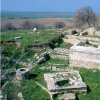Archaeological Site of Troy
 Little Brief About Troy
Little Brief About Troy
Troy, with its 4,000 years of history, is one of the most famous archaeological sites in the world. The first excavations at the site were undertaken by the famous archaeologist Heinrich Schliemann in 1870. In scientific terms, its extensive remains are the most significant demonstration of the first contact between the civilizations of Anatolia and the Mediterranean world. Moreover, the siege of Troy by Spartan and Achaean warriors from Greece in the 13th or 12th century B.C., immortalized by Homer in the Iliad, has inspired great creative artists throughout the world ever since.
History of Troy
Human occupation on the site of Troy (Ilion) began in the Early Bronze Age (late 4th millennium BC). The first defensive wall round the citadel was built around 3000 BC and expanded twice, attaining a diameter of c 110m at the end of Phase I, around 2500 BC.
There was steady development and regularization of the settlement plan in the following five centuries (Troy IIV) to the end of the Early Bronze Age. Around 2000 BC there was a dramatic cultural change, with reconstruction of houses and walls in stone. The town expanded considerably outside the original walled settlement, and Troy VI (from c 1700 BC) may have covered the entire plateau, making it one of the largest towns in the Aegean region. Goods imported from Mycenae and elsewhere in Greece give an indication of its important trading role.
An earthquake in c 1350 BC caused grave damage to Troy VI, with defensive walls and houses collapsing, but the town quickly recovered and was rebuilt in a more orderly layout. The evidence of widespread fire and slaughter around 1250 BC, which brought Troy VIIA to an end, has led to this phase being identified with the city besieged by the Greeks during the Trojan War, immortalized in The Iliad. What is known of the economic and political history of the Aegean region in this period suggests that the real cause of the Trojan War was intense commercial rivalry between Troy and the mercantile Mycenaean kingdom, the prize being control of the Dardanelles and the lucrative trade with the Black Sea.
The town was to be rebuilt once again, but Bronze Age Troy, having most likely lost its commercial supremacy, had been abandoned by the end of the 2nd millennium BC. The site was reoccupied by Greek settlers from Lemnos in the 8th century BC (Troy VIII), and it assumed considerable importance in 306 BC as the capital of a league of cities in the Troad.
In 188 BC it was identified by the Romans as the Ilion of Homer and recognized as the mother-city of Rome (Ilium Novum), being granted exemption from taxes. It was sacked in 85 BC during the Mithridatic War and not rebuilt until around 20 BC, following a visit by Augustus. The town prospered under Roman rule, despite being devastated by Herulian raiders in AD 267, and survived a severe earthquake in the early 6th century. Abandoned once again in the 9th century, it was reoccupied in the later Byzantine period and not finally deserted until well into the Ottoman period.
 Little Brief About Troy
Little Brief About Troy